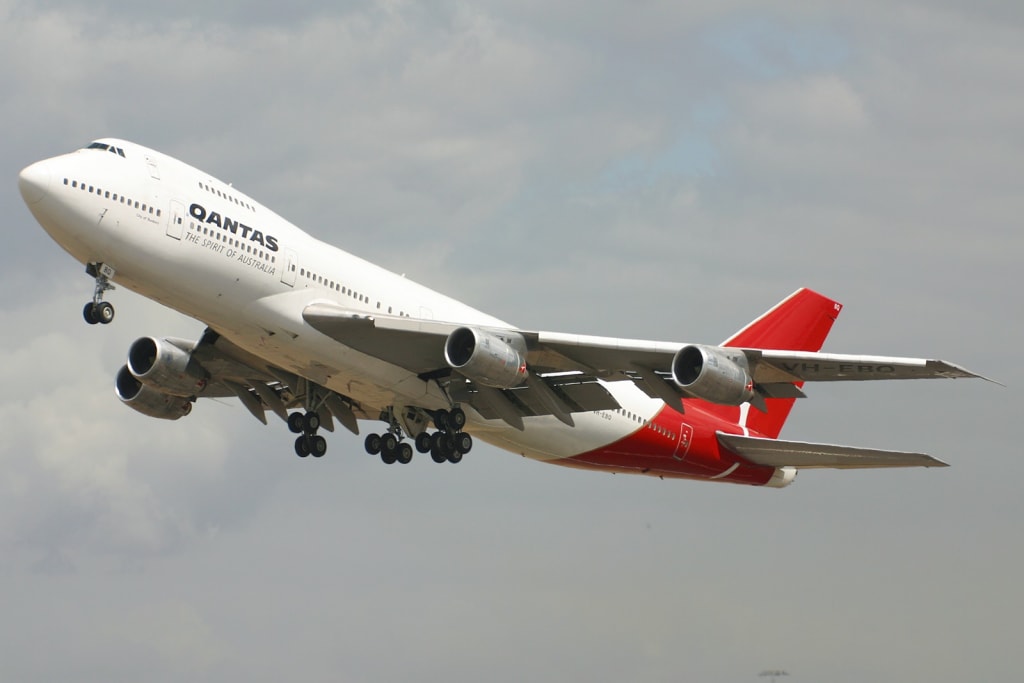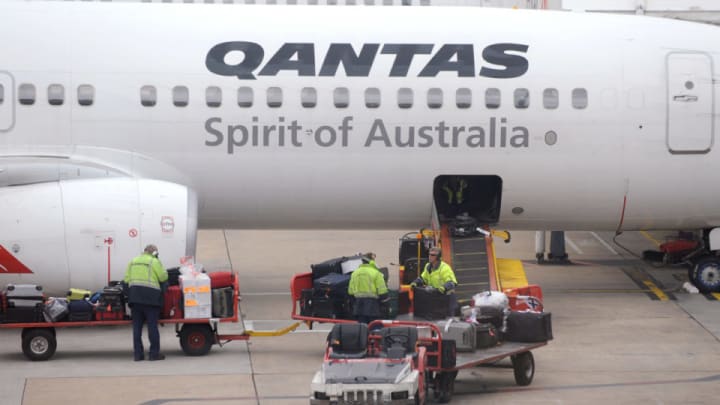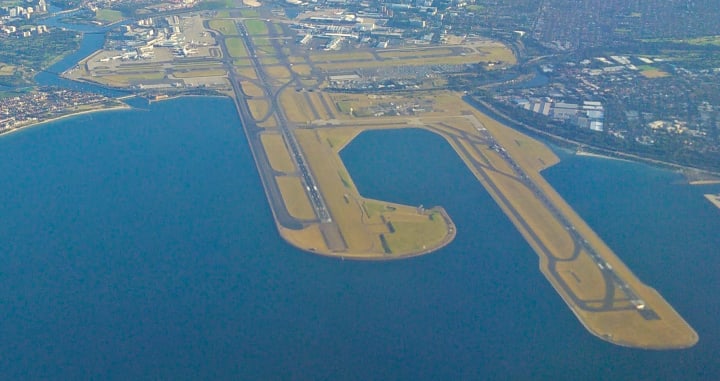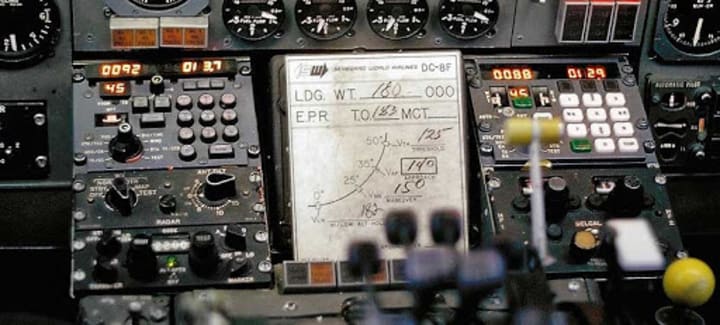Touchdown, Take-Off: Inside a Jumbo Flight
Behind every airline flight is an army of people and a phalange of technology that makes every take-off and landing possible.

FORTY MINUTES before scheduled take-off of this Qantas Boeing 747–200, the technical crew arrives: the captain, the first officer (or co-pilot) and the flight engineer. Each carries a thick, ring-bound folder, the Quick Reference Manual, with a slew of instrumentation and safety checks they will perform over the next half-hour.
Outside, engineers have been crawling along the length of the plane for the past 30 minutes, poking and prodding at valves and hoses and opening hatches like a pit-stop crew in a Formula One race.
In the cockpit, the pilots talk in short staccato quips, take notes with gold-plated pens and all have razor-sharp haircuts. They exhibit an ease and familiarity with both the technology and each other that harks to a collegiality of adventure in times gone by.
But the business of flying a commercial airliner today is a carefully coordinated symphony involving hundreds of people working round-the-clock. It’s certainly a lot more complicated than it was in the days when pilots carried their own tools for spot repairs, landed in paddocks and hunted rabbits for their passengers’ dinner. Pilots for Australia’s Qantas — the world’s third oldest airline— actually used to do this in the 1920s, when a flight from Charleville to Cloncurry in Queensland (about 860 km) took two days and involved an overnight stay in Longreach, about 200 km away.

In many ways, flying a scheduled passenger service today — particularly the plane once dubbed ‘Queen of the Skies’, the jumbo jet — is a lot like a space mission.
It begins with air traffic control, where a flight plan is lodged long before take-off. A team of 12 flight planners at Qantas headquarters do nothing but draw up flight plans for the airline’s 4,200 domestic and international flights on an average (pre-pandemic) week. They allocate planes to the 96 routes and plan schedules to satisfy anticipated passenger demand while still meeting crew roster and plane maintenance requirements.
Then, about an hour before a flight, the technical crew gathers for a briefing over a coffee or tea in a room near the airport. They look over navigation charts of the route they are to fly, along with weather forecasts and any NOTAMs (notice to airmen) issued by air traffic control for that route: unserviceable navigation beacons, broken runway lights, new runway or taxiways opened, and so on. Then they take a bus the short distance to the departure gate of the airport, where they board a half-hour before the passengers.
In the cockpit, they review the technical log: the airplane’s complete maintenance history, past breakdowns, repairs completed and due, and known problems (from a cracked gauge panel to a malfunctioning toilet).
Today I’m flying the 747–200 from Sydney to Auckland and back in a day. On the way to New Zealand, we’ll be under the command of Senior Check Captain Peter Probert, a handsome devil with a cheeky grin and four gold stripes on his epaulettes. First Officer is Richard Coleman, a grey-haired, thin-set character with sharp eyes and a constant five o’clock shadow. Behind them is Flight Engineer Frank Barnes, his mousey-brown hair speckled with grey and the only one to wear glasses.
A solid grey sky hangs above our plane, The City of Broken Hill, a sturdy 70-metre-long aircraft with a wingspan of 60 metres and soon to fill with a complement of 340 souls, as they say in the flying trade.

Below the technical crew, the last of the luggage is being shunted down kilometres of belts by a computerised laser array that reads the destination on each bag’s bar-code and pummels it into the spillway for its designated flight.
Here, beneath the gate where passengers have started to board, baggage handlers load the three cargo holds front and rear, according to an orderly, pre-arranged pattern set by computerised load balancers. Baggage is split across the holds according to weight, their distribution calculated in order to balance the aircraft, so neither front nor aft is overly heavy or overly light. This is not only so the plane is not overloaded on any one side, but to ensure it is ‘trimmed for optimal fuel burn’: balanced so the least amount of fuel will have to be used to keep the airplane stable during flight.
Sweaty engineers in blue overalls and walkie-talkies troop in and out of the cockpit, grasping clipboards and wearing earpieces tuned to the ground crew frequency. They sit in the cockpit for a time, going through the checks with the technical crew and getting their paperwork signed by the captain. Ground crew are the men and women the technical crew depend on: to ensure the required fuel has been loaded, landing gear checked and cargo holds secured. Some captains do their own quick tour of the underbelly before take-off; some out of habit, some out of tradition, some out of superstition.
With the checks complete, the engineers clear out and the technical crew go through their last checks, ticking their ring-binders and flicking switches above them. Captain Probert asks for a cabin check, and Flight Engineer Barnes intercoms the cabin. All passengers are in.

“Anyway, let’s push off,” says Probert. The doors are sealed, and the engines fired up. The aircraft begins to reverse, at first gingerly, then faster as it turns. By the time the plane taxis the half-kilometre to the runway departure point, the engines will be warm enough to take to the skies.
“Qantas 43, taxi for Alpha departure, hold short of runway seven,” the voice of the ground controller crackles over the speaker.
“Taxi for Alpha hold short of seven, Qantas 43,” replies Probert into his headset.
The plane taxis out, stopping for a while between runways to allow a smaller Boeing 737 to scream past at it takes off, its engines howling as it lifts into the sky.
“Qantas 43, proceed runway two-five, taxi for an Alpha 6 departure. Approaching A6, call Sydney Tower on one-two-zero decimal five,” crackles the radio.
“Runway two-five, taxi for an Alpha 6, Qantas 43,” replies Probert.
We begin moving forward again, getting into position for a northerly departure from Sydney’s Kingsford-Smith Airport, which just about everyone except the mapmakers calls Mascot Airport, after the Sydney suburb it’s in.

“Sydney Tower, Qantas 43 ready,” Probert says. The plane is on the tarmac for less than a minute before the clearance comes. “Qantas 43, you are clear for an Alpha 6 take-off.” Probert replies immediately: “Alpha 6 take-off, Qantas 43.”
Both Probert and his co-pilot slowly push the multi-coloured thrusters levers up, and the aircraft rumbles forward. Soon, it is tearing along, and both Probert and Coleman begin to pull up on their joysticks, their voices drowned out by the din of the engines.
And then, suddenly, we’re away, clear of the ground and flashing past the jetties, refineries and parklands below, making a graceful arc to the left as we rise into the grey sky. We are headed inland, rising to the 1,500 feet authorised by the control tower until the plane passes a navigation beacon in Richmond, where it is cleared to rise to 5,000 feet.
At 1,500 metres and still headed inland, Probert calls the tower on a new frequency as requested. They clear the plane to go higher: “Qantas 43, you are cleared for flight level 280,” says the tower; this authorises the plane to rise to 28,000 feet, and soon, to begin its journey back east and toward New Zealand. “Qantas 43, turn right, track direct to LOTSA,” says the tower.
With the flaps now retracted, the co-pilot Coleman begins to accelerate the plane, pushing the thrusters forward a bit more. Barnes leans in and taps the thrusters, nudging one here and there. Then the flight engineer begins to reel off a series of numbers to the captain, who takes notes in his folder: fuel consumption rate per engine, thrust, engine temperature, and so on. While Coleman swings the 747–200 around, Probert and Barnes look over their maps. Today we’ll be taking route LOTSA to Auckland, one of the many thick coloured lines that radiate out from the circle marked ‘Sydney’.

“This is a highway map of the sky,” shouts Barnes as he leans across and uncups the radio headset from one of his ears. “Routes have different colours with numbers indicating course changes you need to make to stay within that route.”
In this way, even when the jumbo drops off the radar scope at Sydney, traffic control will know where the jumbo is supposed to be at any one time, and can move incoming planes around it. LOTSA is also an outbound lane out of Sydney; in theory, no inbound plane will use this route when heading for Sydney.
So why does Barnes fiddle with the thrusters after the pilots have set them? “The systems have an inherent hysteresis in them,” he says. “When all four throttles move up, there’ll be a slight error … one engine will be giving less power than another. All I’m doing is trimming it up, keeping balanced thrust.”
Suddenly, the speakers come alive. It’s the captain: “Ladies and gentlemen, welcome aboard Qantas 43 to Auckland … Expected flight time today around two hours and 30 minutes. We will be cruising at about 37,000 feet. Once we’ve settled down and pointed in the right direction, we’ll give you some more details of our journey. Please settle back and make yourselves comfortable.”
Unlike the comfortable cabin behind and below it, the cockpit is a relatively cramped and noisy place. The hiss of air pressure can be heard over everything, and your attention is constantly being called by the radio headsets. There is a sporadic but unending stream of talk on the radio: inbound planes giving their position, traffic controllers giving them new heights (or ‘ceilings’) to take, or planes entering radio range identifying themselves to the air traffic control tower.
As we speed further and further away from Sydney, the din of radio chatter drops away. We change frequencies and tune to Brisbane air traffic control, the tower that oversees flights across the Tasman Sea, or ‘the ditch’ between Australia and New Zealand, as the pilots call it.
The plane is now punching through the sky at just over 890 km an hour. On board, navigation is provided by INS, or inertial navigation system. This is not your fancy satellite-based GPS (global positioning system), but a much older form of navigation that existed before communications satellites. Basically, an on-board computer keeps track of where the plane is by calculating its departure point, speed and direction, and matching this to a map. In the old days, pilots would do this by hand, using dividers and pencils.


“It knows where its starting point is, how long it’s travelled in what direction, its ground speed, drift angles and therefore where it is at any one time,” says Probert. “It’s quite accurate. But yeah, GPS is more so. It would be able to tell you exactly where you are at any one time to a few metres. But you don’t really need that kind of accuracy to fly.”
And you don’t. These planes have been flying since 1971, when the first 747 took to the air. More than 1,100 still cruise the skies, and the 747 series has travelled a total of 52 billion km — that’s Mars and back 664 times. The City of Broken Hill is one of the 993 of the world’s 747–200s, and was completed in 1989.
As we speed over the Tasman Sea, the four engines are burning 233 kilos of aviation fuel per minute. The temperature near the combustion chamber — a readout of which appears in the cockpit — reads 667°C, and the jet blades are spinning at 97% of their highest RPM, or revolutions per minute. They are jet engines: drawing in air, heating and compressing it, then shooting it out the back.
“The principle is simple,” says Barnes. “They all go suck, squeeze and bang.”

Inside the cockpit, percolated coffee and a cut lunch arrives. Meanwhile, the cabin crew begin to serve wine and chicken Provençale to the passengers.
Helen Yule is the chief steward on the flight, or what is these days called a customer service manager. She’s flicking through the special handling list for the flight, looking for passengers with particular needs like halal meals, those who are hard-of-hearing and where they sit, those who will need wheelchair assistance when they land, etc.
On another list appear known background of people on the flights: VIPs, frequent flyer members and the all-important doctors who can be called upon during an in-flight emergency — although often those listed as doctors end up being not the medical kind. “We’ve quite a number of nurses and a couple of doctors working as flight attendants,” says Yule, whom everyone calls ‘Pixie’. “On long flights we have a lot of elderly people who can suffer from lack of oxygen and other problems, so it helps having nurses on staff.”
Her most dramatic medical emergency was a few years ago when, flying on a 747–400 and barely an hour from arriving in Bangkok from Sydney, Pixie was called by a passenger who had stomach pains. It quickly emerged that the Indian woman was very pregnant and getting contractions every two minutes. The stewards carried the woman to the galley, laid down plastic and towels, and called for a doctor.
What they got was an ophthalmologist; luckily, his wife was a gynaecologist who hadn’t practised for a few years. Pixie hooked the woman up to oxygen, and a difficult birth ensued: a pro-lapsed cord and footling breach that would have required a 10-person team on the ground. Nevertheless, baby was born before touchdown and later the crew visited mother and child to find both were well.

n hour or so later, about 99 nautical miles out of Auckland, the plane begins its slow descent. All along the trip, the plane would have followed its designated route, checking in at each waypoint, or navigation marker in the sky, telling Brisbane tower it had reached that waypoint, was headed to the next waypoint, and given an estimated time to that waypoint.
“If they don’t hear from us within two minutes of us hitting that waypoint, they will start hailing us,” said Probert. There will also be FIR boundaries to cross: Flight Information Region boundaries, basically airborne ‘markers’ at which air traffic control towers exchange responsibility for travelling aircraft. These usually match air borders between countries.
The technical crew open their flight books and begin STAR protocol, or STandard ARrival procedure, calculating all of the routing changes and descent movements they will have to make to arrive at their allocated runway. The checklist is methodically gone through at 20,000 feet: fuel tanks and consumption rate, cabin pressure, landing data and prevailing winds.

As the plane descends through the clouds, a landing approach is computed that takes into account the aircraft’s current weight including passengers and baggage, as well as the winds on the approach leg, giving a manoeuvre profile and speed that optimises the fuel burn on descent. On this flight, the jumbo is weighing in at 240 tonnes; this requires a ‘V-Ref’ or velocity reference (runway strike speed) of 137 knots, or nautical miles, equivalent to about 250 km per hour.
With the airport in sight, three radio altimeters on the undercarriage of the plane begin transmitting, sending radio beams to the ground which are bounced back up, giving an exact distance between the pane and the ground. Fifteen nautical miles from the airport, Probert orders flaps put out: this begins the air braking that will slow the plane enough to make a landing. The airport’s ILS tracker is activated: this sends a beam to the aircraft, one horizontal and one vertical, confirming for both the pilots and traffic controller the glidepath the aircraft is taking; usually, a smooth three-degree descent for a jumbo.
The landing gear is deployed, as are most of the flaps. The runway is looming on approach, and the technical crew talk feverishly to the tower and each other in rapid staccato. Finally, the huge lumbering metal bird strikes the runway at exactly 137 knots. The autobrakes cut in and the engines go into reverse thrust, slowing the plane dramatically. Within a few minutes, the plane has slowed to just 30 knots. The pilots look at their map of Auckland airport for the right taxiway to their gate, turn left, and now rumble along at a smooth eight to 10 km an hour.

As the plane approaches the designated gate, the pilots visually check the wingtip clearance, and aim the nose of the plane at a large digital readout in front of the gate. The panel counts down, in feet, the distance of the nosecone to the ground-marker the plane needs to stop at for the passenger gangplank to reach the main door. Finally, the plane comes to a halt; the display reads ‘0’, and the flight is at an end.
“Touchdown,” says Probert, looking back at his guest in the cockpit. I ask him if take-offs and landings are the hardest.
“They’re the most enjoyable,” he smiles. “You get the sense of acceleration, of the aircraft speeding pretty close to the ground. But also, the most challenging.”
Below, the cargo hold is cracked open and bags begin to be unloaded. Engineers check the aircraft from forward to aft, popping open the fuel access panel on the wing for refuelling. The whole process of preparing for take-off begins again, as the aircraft is readied for a return trip to Sydney in less than two hours.
I turn to Probert again. I tell him that an airline pilot once described flying jumbos as being 90% sheer boredom punctuated by 10% sheer terror. He laughs, looking at his co-pilot as they unbuckle from their seats. “I’m sure that wasn’t a Qantas pilot,” he quips.
Like this story? Click the ♥︎ below, or send me a tip. And thanks 😊
About the Creator
Wilson da Silva
Wilson da Silva is a science journalist in Sydney | www.wilsondasilva.com | https://bit.ly/3kIF1SO






Comments
There are no comments for this story
Be the first to respond and start the conversation.